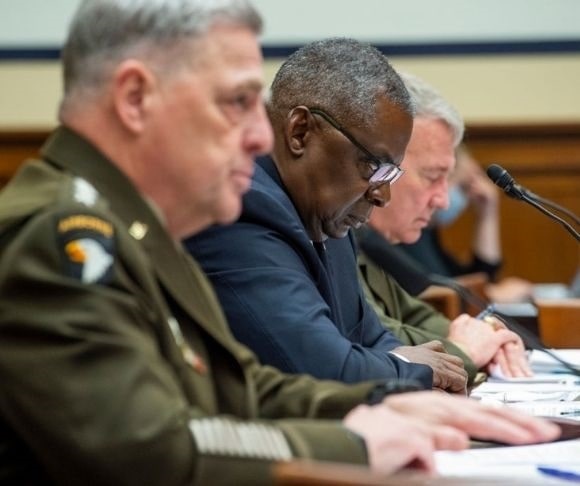Over two days, lawmakers on the Senate Armed Services Committee (SASC) got to hear what went wrong in Afghanistan. Since the whole world watched a first-class U.S. foreign policy debacle take place as the Americans scrambled to get out of Kabul, how would the Defense Department spin the story? Secretary of Defense Lloyd Austin III, Chairman of the Joint Chiefs of Staff Mark Milley, and General Kenneth McKenzie, commander of U.S. Central Command, faced over four hours of questioning: softballs from Democrats, hardballs from most Republicans. The exchanges between witnesses and the committee members revealed three root causes of the Afghanistan failure, though not stated specifically.
 First, a root cause revealed from listening to the three Defense Department witnesses was the ill-conceived withdrawal of U.S. forces, and the fiasco of an evacuation operation fell prey to what can be called the “eaches.” The Biden foreign policy team and the Pentagon made a series of decisions. Each decision by itself was not devastating but had the result of foreclosing other options. Three of the more emblematic are:
First, a root cause revealed from listening to the three Defense Department witnesses was the ill-conceived withdrawal of U.S. forces, and the fiasco of an evacuation operation fell prey to what can be called the “eaches.” The Biden foreign policy team and the Pentagon made a series of decisions. Each decision by itself was not devastating but had the result of foreclosing other options. Three of the more emblematic are:
- Establishing a date certain for withdrawal drove the chaotic scramble to get U.S. forces, embassy personnel, and Afghan allies out of Kabul. General McKenzie stressed establishing the date for withdrawal was a bad idea and went on to explain that such operations should be condition-based.
- Withdrawing close air support on which Afghan Security Forces had depended for the last 20 years contributed to those forces failing. Providing close air support would have left open the option of keeping Taliban forces out of Kabul longer, allowing more time for the U.S. and allies to have a more orderly departure.
- The decision to close Bagram Air Base forced all the evacuation operations to be accomplished from the Hamid Karzai International Airport, a location not defendable. Thus, closing Bagram eliminated the option of a more defendable evacuation location and creating more access for those wishing to leave.
Second, President Biden established the logical fallacy positing a “false choice” for how his Afghanistan policy would be portrayed. The New York Times reported on President Biden’s embrace of the false choice logic, explaining:
“In framing the decision before him as either complete withdrawal or endless escalation, Mr. Biden has been telling the public that there was, in fact, no choice at all because he knew that Americans had long since grown disenchanted with the Afghanistan war and favored getting out. ‘There was only the cold reality of either following through on the agreement to withdraw our forces or escalating the conflict and sending thousands more American troops back into combat in Afghanistan, lurching into the third decade of conflict,’ Mr. Biden said.”
Of course, there were choices short of spending another ten years in Afghanistan and “sending thousands more American troops into combat.” But those choices did not fit Biden’s narrative of ending the “forever war.” To that end, the Pentagon witnesses continued singing from the false choice sheet of music. When questioned by Senator Jacky Rosen (D-NV) about why the U.S. closed Bagram Air Base, General McKenzie responded:
“Very briefly, once we went below 2,500 people in Afghanistan, we lost the ability to hold Bagram Air Base. It was inevitable that we were going to have to come out of Bagram because we ended up in late June or July with 650 Marines and soldiers in the country. It was not feasible to hold Bagram under those circumstances.”
In other words, once the Biden decision to go “below 2,500 people [military forces] in Afghanistan,” there was no other choice but to abandon Bagram. But, of course, there was another choice. Since the U.S. eventually sent “thousands” more troops to Kabul, why not reopen Bagram and send more soldiers and Marines there? However, the false choice logic has an essential dimension. If choices are inevitable, then there is no cause to hold leaders accountable.
 Finally, listening to the testimony, one rightly concludes there was a failure of leadership in Afghanistan and, more critically, in Washington, D.C. The decision-making became calcified. Once the administration decided, there was no turning back. For example, Biden decided that all the troops would come out, so they came out despite military advisors’ recommendations for keeping a residual force behind. When it became clear that all the Americans and Special Immigrant Visa holders could not be evacuated by August 31 – a minor detail – the date would be met no matter what. When leaders are unwilling to be flexible, adjusting plans to meet conditions, debacles like this will result.
Finally, listening to the testimony, one rightly concludes there was a failure of leadership in Afghanistan and, more critically, in Washington, D.C. The decision-making became calcified. Once the administration decided, there was no turning back. For example, Biden decided that all the troops would come out, so they came out despite military advisors’ recommendations for keeping a residual force behind. When it became clear that all the Americans and Special Immigrant Visa holders could not be evacuated by August 31 – a minor detail – the date would be met no matter what. When leaders are unwilling to be flexible, adjusting plans to meet conditions, debacles like this will result.
As the open portion of the hearing was winding down, the witnesses may have thought there was light at the end of the interrogation tunnel. They were wrong. Senator Marsha Blackburn (R-TN) rounded out her questions with a biting indictment of the Pentagon’s most senior leadership, “maybe we are going to remember you as the three who broke the military.” Senator Josh Hawley (R-MO) was less subtle, calling for Chairman Milley and Secretary Austin to resign for their culpability in creating the Afghanistan mess. It’s doubtful they will, but the pain of explaining failure is not going away.
The views expressed are those of the author and not of any other affiliation.
~ Read more from Dave Patterson.




